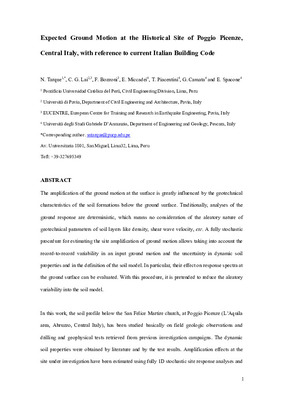| dc.contributor.author | Tarque, N. | |
| dc.contributor.author | Lai, C. G. | |
| dc.contributor.author | Bozzoni, F. | |
| dc.contributor.author | Miccadei, E. | |
| dc.contributor.author | Piacentini, T. | |
| dc.contributor.author | Camata, G. | |
| dc.contributor.author | Spacone, E. | |
| dc.date.accessioned | 2024-01-31T13:39:58Z | |
| dc.date.available | 2024-01-31T13:39:58Z | |
| dc.date.issued | 2013 | |
| dc.identifier.uri | https://repositorio.pucp.edu.pe/index/handle/123456789/196972 | |
| dc.description.abstract | The amplification of the ground motion at the surface is greatly influenced by the geotechnical characteristics of the soil formations below the ground surface. Traditionally, analyses of the ground response are deterministic, which means no consideration of the aleatory nature of geotechnical parameters of soil layers like density, shear wave velocity, etc. A fully stochastic procedure for estimating the site amplification of ground motion allows taking into account the record-to-record variability in an input ground motion and the uncertainty in dynamic soil properties and in the definition of the soil model. In particular, their effect on response spectra at the ground surface can be evaluated. With this procedure, it is pretended to reduce the aleatory variability into the soil model. In this work, the soil profile below the San Felice Martire church, at Poggio Picenze (L’Aquila area, Abruzzo, Central Italy), has been studied basically on field geologic observations and drilling and geophysical tests retrieved from previous investigation campaigns. The dynamic soil properties were obtained by literature and by the test results. Amplification effects at the site under investigation have been estimated using fully 1D stochastic site response analyses and for the object motion 7 real records compatible to the Italian code-based spectrum referred to 475-year return period. The Italian building code defines the reference seismic action in terms of elastic acceleration response spectra derived from the results of a probabilistic seismic hazard study. The results in terms of accelerograms and acceleration response spectrum (with the associated dispersion) indicated a clear amplification of the input motion at the basement of San Felice Martire church due to the lithostratigraphic characteristics of the soil deposits at the site under investigation. | es_ES |
| dc.language.iso | eng | es_ES |
| dc.rights | info:eu-repo/semantics/openAccess | es_ES |
| dc.rights.uri | http://creativecommons.org/licenses/by-nc-nd/2.5/pe/ | * |
| dc.subject | Ground response | es_ES |
| dc.subject | 1D stochastic analysis | es_ES |
| dc.subject | Site amplification | es_ES |
| dc.subject | Seismic input definition | es_ES |
| dc.subject | Poggio Picenze | es_ES |
| dc.subject | Italian building code | es_ES |
| dc.title | Expected Ground Motion at the Historical Site of Poggio Picenze, Central Italy, with reference to current Italian Building Code | es_ES |
| dc.type | info:eu-repo/semantics/preprint | |
| dc.type.other | Preimpresión | |
| dc.subject.ocde | https://purl.org/pe-repo/ocde/ford#2.01.01 | es_ES |
| dc.publisher.country | US | es_ES |
| dc.relation.publisherversion | https://doi.org/10.1016/j.enggeo.2013.09.003 | |
| dc.type.version | info:eu-repo/semantics/submittedVersion | |


